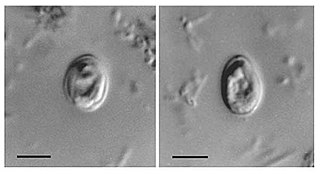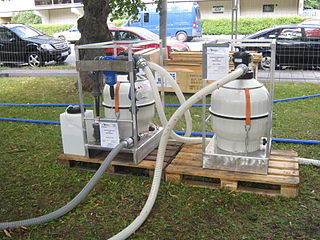Related Research Articles

Lough Corrib is a lake in the west of Ireland. The River Corrib or Galway River connects the lake to the sea at Galway. It is the largest lake within the Republic of Ireland and the second largest on the island of Ireland. It covers 176 km² and lies mostly in County Galway with a small area of its northeast corner in County Mayo.

Queenstown is a resort town in Otago in the south-west of New Zealand's South Island. It has an urban population of 29,000.

Drinking water or potable water is water that is safe for ingestion, either when drunk directly in liquid form or consumed indirectly through food preparation. It is often supplied through taps in which case it is also called tap water. Typically in developed countries, tap water meets drinking water quality standards, even though only a small proportion is actually consumed or used in food preparation. Other typical uses for tap water include washing, toilets, and irrigation. Greywater may also be used for toilets or irrigation. Its use for irrigation however may be associated with risks.

Water purification is the process of removing undesirable chemicals, biological contaminants, suspended solids, and gases from water. The goal is to produce water that is fit for specific purposes. Most water is purified and disinfected for human consumption, but water purification may also be carried out for a variety of other purposes, including medical, pharmacological, chemical, and industrial applications. The history of water purification includes a wide variety of methods. The methods used include physical processes such as filtration, sedimentation, and distillation; biological processes such as slow sand filters or biologically active carbon; chemical processes such as flocculation and chlorination; and the use of electromagnetic radiation such as ultraviolet light.

Cryptosporidiosis, sometimes informally called crypto, is a parasitic disease caused by Cryptosporidium, a genus of protozoan parasites in the phylum Apicomplexa. It affects the distal small intestine and can affect the respiratory tract in both immunocompetent and immunocompromised individuals, resulting in watery diarrhea with or without an unexplained cough. In immunosuppressed individuals, the symptoms are particularly severe and can be fatal. It is primarily spread through the fecal-oral route, often through contaminated water; recent evidence suggests that it can also be transmitted via fomites contaminated with respiratory secretions.

United Utilities Group plc (UU), the United Kingdom's largest listed water company, was founded in 1995 as a result of the merger of North West Water and NORWEB. The group manages the regulated water and waste water network in North West England, which includes Cumbria, Greater Manchester, Lancashire, Merseyside, most of Cheshire and a small area of Derbyshire, which have a combined population of more than seven million.

Cryptosporidium parvum is one of several species that cause cryptosporidiosis, a parasitic disease of the mammalian intestinal tract.

Cryptosporidium, sometimes called crypto, is an apicomplexan genus of alveolates which are parasites that can cause a respiratory and gastrointestinal illness (cryptosporidiosis) that primarily involves watery diarrhea, sometimes with a persistent cough.
Wilderness-acquired diarrhea is a variety of traveler's diarrhea in which backpackers and other outdoor enthusiasts are affected. Potential sources are contaminated food or water, or "hand-to-mouth", directly from another person who is infected. Cases generally resolve spontaneously, with or without treatment, and the cause is typically unknown. The National Outdoor Leadership School has recorded about one incident per 5,000 person-field days by following strict protocols on hygiene and water treatment. More limited, separate studies have presented highly varied estimated rates of affliction that range from 3 percent to 74 percent of wilderness visitors. One survey found that long-distance Appalachian Trail hikers reported diarrhea as their most common illness. Based on reviews of epidemiologic data and literature, some researchers believe that the risks have been over-stated and are poorly understood by the public.
A boil-water advisory (BWA), boil-water notice, boil-water warning, boil-water order, or boil order is a public-health advisory or directive issued by governmental or other health authorities to consumers when a community's drinking water is or could be contaminated by pathogens.
The 1993 Milwaukee cryptosporidiosis outbreak was a significant distribution of the Cryptosporidium protozoan in Milwaukee, Wisconsin, and the largest waterborne disease outbreak in documented United States history. It is suspected that The Howard Avenue Water Purification Plant, one of two water treatment plants in Milwaukee at the time, was contaminated. It is believed that the contamination was due to an ineffective filtration process. Approximately 403,000 residents were affected resulting in illness and hospitalization. Immediate repairs were made to the treatment facilities along with continued infrastructure upgrades during the 25 years since the outbreak. The total cost of the outbreak, in productivity loss and medical expenses, was $96 million. At least 69 people died as a result of the outbreak. The city of Milwaukee has spent upwards to $510 million in repairs, upgrades, and outreach to citizens.

Portable water purification devices are self-contained, easily transported units used to purify water from untreated sources for drinking purposes. Their main function is to eliminate pathogens, and often also of suspended solids and some unpalatable or toxic compounds.

The 1998 Sydney water crisis involved the suspected contamination of the water supply system of Greater Metropolitan Sydney by the microscopic pathogens Cryptosporidium and Giardia between July and September 1998.

An instant hot water dispenser or boiling water tap is an appliance that dispenses water at about 94 °C (201 °F) (near-boiling). There are hot-only and hot and cool water models, and the water may be filtered as well as heated. Instant hot water dispensers became popular in the 1970s. Instant hot water dispensers are very similar to portable shower devices; the latter is fitted with a heating element and quickly heats up water, once a switch has been activated.

Water supply and sanitation in New Zealand is provided for most people by infrastructure owned by territorial authorities including city councils in urban areas and district councils in rural areas. As at 2021, there are 67 different asset-owning organisations.
The mayor of Queenstown-Lakes in New Zealand presides over the Queenstown-Lakes District Council. The district council has existed since 1986 and there have been seven mayors so far.
The 1987 Carroll County cryptosporidiosis outbreak was a significant distribution of the Cryptosporidium protozoan in Carroll County, Georgia. Between January 12 and February 7, 1987, approximately 13,000 of the 65,000 residents of the county suffered intestinal illness caused by the Cryptosporidium parasite. Cryptosporidiosis is characterized by watery diarrhea, stomach cramps or pain, dehydration, nausea, vomiting and fever. Symptoms typically last for 1–4 weeks in immunocompetent individuals.
The Water Services Reform Programme is a public infrastructure restructuring programme launched by the Sixth Labour Government to centralise the management of water supply and sanitation in New Zealand. It originally proposed shifting control of stormwater, drinking water and wastewater management from the country's 67 local councils to several new publicly-owned regional entities by July 2024. Details of the proposed reforms were announced in October 2021. The Three Waters reforms were criticised by several mayors and the opposition National and ACT parties.
The 2023 southern New Zealand floods were caused by heavy rain that struck the southern part of New Zealand's South Island on 21 September 2023. This storm caused flooding in several places across the Southland and Otago regions including Gore and Queenstown. 100 homes were evacuated in Queenstown and Tuatapere's water treatment plant was damaged. A state of emergency was declared in the Southland Region. In addition, a state of emergency was declared in Queenstown on 22 September, which recorded its wettest day in 24 years.
References
- 1 2 3 "Cases rise to 15 in first gastro outbreak in Queenstown for 40 years". NZ Herald. 21 September 2023. Archived from the original on 20 September 2023. Retrieved 21 September 2023.
- 1 2 3 "Animal waste 'most likely' source of Queenstown gastro outbreak – expert". 1 News. Archived from the original on 3 October 2023. Retrieved 21 September 2023.
- 1 2 Radcliffe, Debbie Jamieson and Kiah (21 September 2023). "Queenstown council faces $30m water upgrade as restaurants face months of imported tank water". Stuff. Archived from the original on 24 September 2023. Retrieved 24 September 2023.
- 1 2 3 "Investigation into Queenstown's cryptosporidium outbreak intensifies, will leave 'no stone unturned'". Stuff. 23 September 2023. Archived from the original on 24 September 2023. Retrieved 24 September 2023.
- ↑ Littlewood, Matthew (29 September 2023). "Three hospitalised since crypto outbreak began". Otago Daily Times Online News. Archived from the original on 2 October 2023. Retrieved 1 October 2023.
- 1 2 3 Jack, Amberleigh (18 September 2023). "Queenstown and Frankton residents warned to boil water after eight people confirmed sick". Stuff. Archived from the original on 18 September 2023. Retrieved 21 September 2023.
- ↑ "QLDC clears water supply as Fernhill gets slammed by gastro bug". Crux. Archived from the original on 3 October 2023. Retrieved 21 September 2023.
- 1 2 "More than 50 cases of cryptosporidium as Queenstown outbreak grows". RNZ. 1 October 2023. Archived from the original on 3 October 2023. Retrieved 1 October 2023.
- ↑ "Queenstown gets equipment to help fight cryptosporidium outbreak, now at 48 cases". RNZ. 29 September 2023. Archived from the original on 30 September 2023. Retrieved 1 October 2023.
- ↑ Interactive (https://www.nvinteractive.com), N. V. (21 September 2023). "Update from QLDC regarding cryptosporidium outbreak in Queenstown". www.qldc.govt.nz. Archived from the original on 25 September 2023. Retrieved 25 September 2023.
- 1 2 3 Reporter, Regional (6 October 2023). "Human faeces likely cause of Queenstown cryptosporidium outbreak". Stuff. Archived from the original on 6 October 2023. Retrieved 7 October 2023.
- 1 2 "84 water suppliers do not have sufficient UV filtering facilities, Taumata Arowai says". Radio New Zealand . 5 October 2023. Archived from the original on 5 October 2023. Retrieved 6 October 2023.
- ↑ "One swimmer could have caused Queenstown cryptosporidiosis outbreak". Radio New Zealand . 7 October 2023. Archived from the original on 14 October 2023. Retrieved 14 October 2023.
- ↑ "29 confirmed cases of cryptosporidium in Queenstown". Archived from the original on 3 October 2023. Retrieved 23 September 2023.
- ↑ "Queenstown gets equipment to help fight cryptosporidium outbreak, now at 48 cases". Radio New Zealand . 29 September 2023. Archived from the original on 30 September 2023. Retrieved 1 October 2023.
- ↑ "Cryptosporidium: 60 confirmed cases in Queenstown outbreak". Radio New Zealand . 2 October 2023. Archived from the original on 2 October 2023. Retrieved 2 October 2023.
- ↑ "Crypto cases still rising in Queenstown". Otago Daily Times Online News. 10 October 2023. Retrieved 14 October 2023.
- ↑ "Queenstown cryptosporidium outbreak: Four more weeks of boiling water". RNZ. 14 November 2023. Retrieved 15 November 2023.
- ↑ "Queenstown cryptosporidium outbreak: Special filter sourced for Two Mile water supply". Archived from the original on 22 September 2023. Retrieved 23 September 2023.
- ↑ ""Prosecution has a cost": Regulators prefer to invest in water safety". Newstalk ZB . 6 October 2023. Archived from the original on 6 October 2023. Retrieved 6 October 2023.